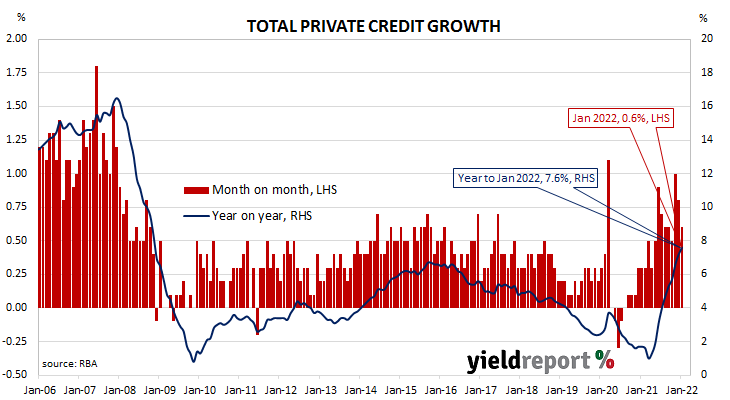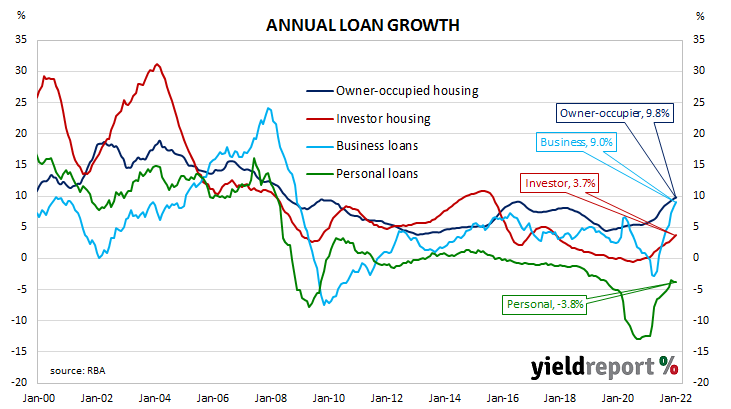Summary: Private sector credit up 0.6% in January, below +0.7% expected; annual growth rate rises from 7.2% to 7.6%; business credit “remains very strong”; “underlying strength” in business capex, sector responding to strong household demand, generous tax incentives; owner-occupier loans account for about 45% of net growth, business loans account for 35%; investor lending slows, personal loans down again.
The pace of lending to the non-bank private sector by financial institutions in Australia followed a steady-but-gradual downtrend from late-2015 through to early 2020 before hitting what appears to be a nadir in March 2021. That downtrend ended later in the same year and now annual growth rates are above the peak rate seen in the previous decade.
According to the latest RBA figures, private sector credit growth increased by 0.6% in January. The result was slightly below the generally expected figure of 0.7% as well as December’s 0.8% increase. On an annual basis, the growth rate increased from 7.2% to 7.6%.
“The slowdown in the aggregate number was on the back of slowing business credit, which fell back to +0.6% after two very strong consecutive months of above-1% growth. Business credit overall remains very strong at 10.9% on a six-month annualised basis,” said NAB economist Taylor Nugent.
Commonwealth Government bond yields fell sharply on the day as investors reassessed central banks’ plans in light of events relating to Ukraine and financial sanctions on Russia. By the close of business, the 3-year ACGB yield had shed 13bps to 1.58%, the 10-year yield had lost 9bps to 2.15% while the 20-year yield finished 11bps lower at 2.55%.
In the cash futures market, expectations of any material change in the actual cash rate, currently at 0.05%, remained fairly soft for the next few months. At the end of the day, contract prices implied the cash rate would not exceed the RBA’s 0.10% target rate until June and then rise to 0.40% by August. February 2023 contracts implied a cash rate of 1.305%.
“As well as businesses accessing lines of credit to ease cash flow pressures during lockdown, there is underlying strength in business spending on equipment investment, some of which is funded by additional borrowing,” said Westpac senior economist Andrew Hanlan.
He said the business sector was responding to strong household demand as well a generous tax incentives and expects demand to remain strong and thus “be supportive of underlying lending for the business sector during 2022.”
Owner-occupier loans accounted for about 45% of the net growth over the month, while business loans and investor loans accounted for around 35% and 20% respectively. Total personal debt shrank again.
The traditional driver of loan growth rates, the owner-occupier segment, grew by 0.8% over the month, in line with increases from August onwards. The sector’s 12-month growth rate accelerated from 9.6% to 9.8%.
Total lending in the business sector grew by 0.6%, slightly below the long-term monthly average but considerably less than the 1.1% increase recorded in December. The segment’s annual growth rate increased from 8.4% to 9.0
Monthly growth in the investor-lending segment slowed to a halt in early 2018. Shortly into the 2019/20 financial year, monthly growth rates slipped into the red before posting a series of flat or near-flat results until late 2020. Growth rates then became positive again from December 2020. In January, net lending grew by 0.4%, slightly slower than December’s 0.5%. The 12-month growth rate accelerated from 3.4% to 3.7%.
Total personal loans fell by 0.6% in January, a slightly slower rate of contraction than December’s -0.8%, maintaining the annual contraction rate at 3.8%. This category of debt includes fixed-term loans for large personal expenditures, credit cards and other revolving credit facilities.



